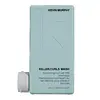What's inside
What's inside
 Key Ingredients
Key Ingredients

 Benefits
Benefits

 Concerns
Concerns

 Ingredients Side-by-side
Ingredients Side-by-side

Water
Skin ConditioningSodium Lauroyl Methyl Isethionate
CleansingCocamidopropyl Betaine
CleansingPropanediol
SolventAcrylates Crosspolymer-4
Emulsion StabilisingCocamidopropyl Hydroxysultaine
CleansingGlycerin
HumectantAminomethyl Propanol
BufferingGlycol Distearate
EmollientAloe Barbadensis Leaf Juice
Skin ConditioningAvena Sativa Kernel Extract
AbrasiveAmaranthus Caudatus Seed Extract
Skin ConditioningHydrolyzed Rice Protein
Skin ConditioningHydrolyzed Quinoa
Skin ConditioningCetrimonium Chloride
AntimicrobialPolyquaternium-10
Ethylhexylglycerin
Skin ConditioningPhenoxyethanol
PreservativeSodium Hydroxide
BufferingCitric Acid
BufferingWater, Sodium Lauroyl Methyl Isethionate, Cocamidopropyl Betaine, Propanediol, Acrylates Crosspolymer-4, Cocamidopropyl Hydroxysultaine, Glycerin, Aminomethyl Propanol, Glycol Distearate, Aloe Barbadensis Leaf Juice, Avena Sativa Kernel Extract, Amaranthus Caudatus Seed Extract, Hydrolyzed Rice Protein, Hydrolyzed Quinoa, Cetrimonium Chloride, Polyquaternium-10, Ethylhexylglycerin, Phenoxyethanol, Sodium Hydroxide, Citric Acid
Water
Skin ConditioningSodium C14-16 Olefin Sulfonate
CleansingCocamidopropyl Hydroxysultaine
CleansingPropanediol
SolventAcrylates Copolymer
Glycol Distearate
EmollientAvena Sativa Kernel Extract
AbrasiveXanthan Gum
EmulsifyingGlycine Soja Oil
EmollientRicinus Communis Seed Oil
MaskingPhospholipids
Skin ConditioningGlycine Soja Sterols
EmollientHydroxyacetophenone
AntioxidantLauryl Lactyl Lactate
Skin ConditioningGlycolipids
Skin ConditioningGuar Hydroxypropyltrimonium Chloride
Skin ConditioningPEG-150 Distearate
EmulsifyingHydroxyethylcellulose
Emulsion StabilisingTrisodium Ethylenediamine Disuccinate
Phenoxyethanol
PreservativeEthylhexylglycerin
Skin ConditioningChlorphenesin
AntimicrobialPotassium Sorbate
PreservativeSodium Benzoate
MaskingCitric Acid
BufferingSodium Hydroxide
BufferingParfum
MaskingWater, Sodium C14-16 Olefin Sulfonate, Cocamidopropyl Hydroxysultaine, Propanediol, Acrylates Copolymer, Glycol Distearate, Avena Sativa Kernel Extract, Xanthan Gum, Glycine Soja Oil, Ricinus Communis Seed Oil, Phospholipids, Glycine Soja Sterols, Hydroxyacetophenone, Lauryl Lactyl Lactate, Glycolipids, Guar Hydroxypropyltrimonium Chloride, PEG-150 Distearate, Hydroxyethylcellulose, Trisodium Ethylenediamine Disuccinate, Phenoxyethanol, Ethylhexylglycerin, Chlorphenesin, Potassium Sorbate, Sodium Benzoate, Citric Acid, Sodium Hydroxide, Parfum
Ingredients Explained
These ingredients are found in both products.
Ingredients higher up in an ingredient list are typically present in a larger amount.
Avena Sativa Kernel Extract is is derived from colloidal oatmeal. Besides being a healthy breakfast, oats have many benefits in skincare too.
This ingredient helps sooth, hydrate, and protect the skin. The starches in colloidal oatmeal are able to bind water, keeping the skin hydrated.
The cellulose and fiber in colloidal oatmeal help reduce inflammation. This can also help the skin feel softer.
Colloidal Oatmeal is also an antioxidant. Antioxidants protect our skin from free-radical damage.
Oatmeal also contains beneficial compounds:
This ingredient is created by mixing grounded oatmeal and a liquid base.
Learn more about Avena Sativa Kernel ExtractCitric Acid is an alpha hydroxy acid (AHA) naturally found in citrus fruits like oranges, lemons, and limes.
Like other AHAs, citric acid can exfoliate skin by breaking down the bonds that hold dead skin cells together. This helps reveal smoother and brighter skin underneath.
However, this exfoliating effect only happens at high concentrations (20%) which can be hard to find in cosmetic products.
Due to this, citric acid is usually included in small amounts as a pH adjuster. This helps keep products slightly more acidic and compatible with skin's natural pH.
In skincare formulas, citric acid can:
While it can provide some skin benefits, research shows lactic acid and glycolic acid are generally more effective and less irritating exfoliants.
Most citric acid used in skincare today is made by fermenting sugars (usually from molasses). This synthetic version is identical to the natural citrus form but easier to stabilize and use in formulations.
Read more about some other popular AHA's here:
Learn more about Citric AcidCocamidopropyl Hydroxysultaine is a synthetic cleansing agent, though it is derived from coconut oil.
It is used to enhance the texture of products by boosting lather and thickening the texture. As a cleanser, Cocamidopropyl Hydroxysultaine is mild.
Ethylhexylglycerin (we can't pronounce this either) is commonly used as a preservative and skin softener. It is derived from glyceryl.
You might see Ethylhexylglycerin often paired with other preservatives such as phenoxyethanol. Ethylhexylglycerin has been found to increase the effectiveness of these other preservatives.
Glycol Distearate serves as a pearlizing or opacifying agent in cosmetic products.
It's often included in cleansers and haircare products to give them a lustrous or shimmering appearance.
It is derived from stearic acid, a natural fatty acid commonly found in vegetable oils and animal fats.
Glycol Distearate isn't fungal acne safe.
Learn more about Glycol DistearatePhenoxyethanol is a preservative that has germicide, antimicrobial, and aromatic properties. Studies show that phenoxyethanol can prevent microbial growth. By itself, it has a scent that is similar to that of a rose.
It's often used in formulations along with Caprylyl Glycol to preserve the shelf life of products.
Propanediol is an all-star ingredient. It softens, hydrates, and smooths the skin.
It’s often used to:
Propanediol is not likely to cause sensitivity and considered safe to use. It is derived from corn or petroleum with a clear color and no scent.
Learn more about PropanediolSodium Hydroxide is also known as lye or caustic soda. It is used to adjust the pH of products; many ingredients require a specific pH to be effective.
In small amounts, sodium hydroxide is considered safe to use. However, large amounts may cause chemical burns due to its high alkaline.
Your skin has a natural pH and acid mantle. This acid mantle helps prevent harmful bacteria from breaking through. The acid mantle also helps keep your skin hydrated.
"Alkaline" refers to a high pH level. A low pH level would be considered acidic.
Learn more about Sodium HydroxideWater. It's the most common cosmetic ingredient of all. You'll usually see it at the top of ingredient lists, meaning that it makes up the largest part of the product.
So why is it so popular? Water most often acts as a solvent - this means that it helps dissolve other ingredients into the formulation.
You'll also recognize water as that liquid we all need to stay alive. If you see this, drink a glass of water. Stay hydrated!
Learn more about Water